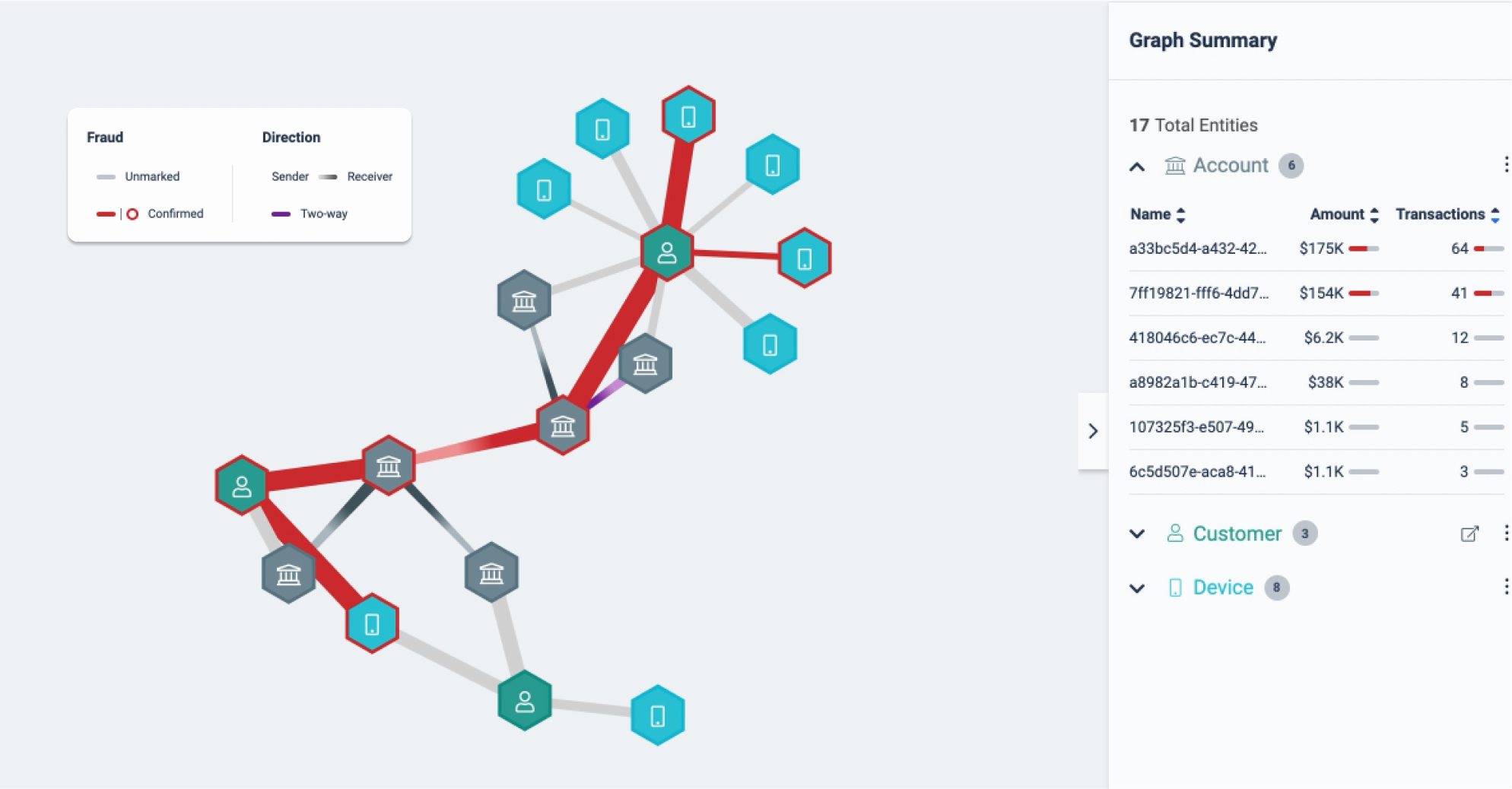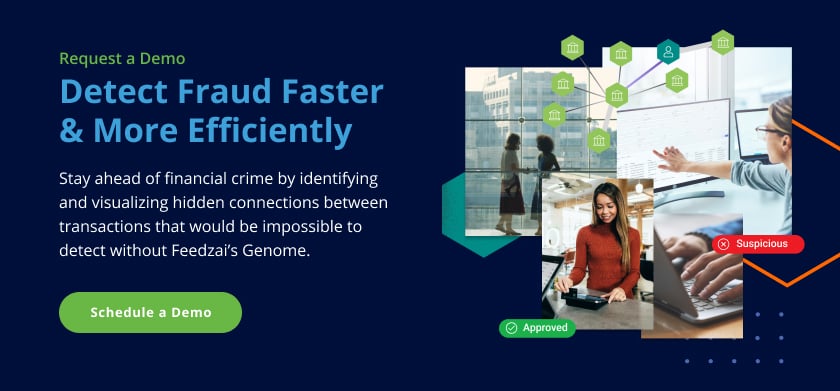
Seeing is believing in the financial crime fight. Some fraud and anti-money laundering analysts may see a stack of alerts awaiting review for suspicious activity. But these alerts only reflect a surface problem. Lying beneath the surface is a broader network of interconnected players powering an intricate criminal operation. Feedzai’s Genome delivers a visual link analysis tool for fraud detection, equipping analysts with graphical data visualizations to efficiently uncover deeper financial crime patterns.
While I’m hungry, let’s use a food metaphor to clarify this point. The stack of alerts that fraud and AML analysts are required to review is just a slice of a much bigger financial crime pie. In order to be effective, analysts need to see more. They need to take a look at the entire financial crime bakery to understand how the people, ingredients, and equipment are intertwined when creating that pie.
Genome pulls back the curtain to reveal the intricate patterns of financial crime, revealing the different parties, accounts, payments, and channels connected to a suspicious event.
With this visualization of illicit actors and transactions at their fingertips, analysts will be able to clearly understand the reach of financial crime. This combined insight and efficiency can make fighting financial crime a piece of cake…oops, I mean pie!
How Feedzai’s Genome Visual Link Analysis Enables Better Fraud Detection
On a typical day, fraud and AML analysts will likely log onto work and start addressing the long list of alerts in their work queue. This means going through each alert one at a time.
Feedzai’s Genome has helped clients process alerts twice as fast and enabled other entities to uncover suspicious activity at ten times the average pace.
The trouble with this approach is that it only shows analysts one side of a much broader picture. Let’s say a customer named Kathy uses her credit card to buy a new pair of shoes that she’s been eyeing online. Nothing alarming here, right?
Unfortunately, it turns out that Kathy isn’t the only one using that credit card for purchases. Someone stole her credit card information and is going on their own shopping spree for a new TV. Buy online, pick up in-store an hour later? How convenient! Once they’ve used it for this big purchase, they put her credit card information on the dark web for sale. And boy, it sells like hotcakes. Or pies. Is it time for lunch yet?
Two days later, Kathy notices these crazy transactions, and she calls her bank to report the fraud. They cancel her card and send her a new one – incurring additional costs for the bank. But the bank needs to connect the dots faster and more efficiently. This credit card was used by so many different people, which could have continued had Kathy not checked her bank account.
Visual Link Analysis is Critical for Effective Fraud Detection
Without a visual link analysis for fraud detection, analysts can’t draw connections between devices, accounts, customers, and different payment channels involved in financial crime. As a result, analysts miss connections between different fraudulent activity or suspicious transactions. Without this insight, banks could be allowing crime rings or bot attacks to continue without disruption.
If financial crime has a shape and form, investigators ought to be able to see it right then and there. Feedzai’s Genome automatically graphs connections between entities and transactions. For example, it can reveal how many transactions were made in a given span of time for a specific customer account. Or it can highlight if a device used to make a transaction is linked to a confirmed fraud case. Being able to see these connections allows analysts to peel back the deeper connections, bringing account takeovers, bot attacks, or organized crime rings to light.


3 Key Problems with Traditional Fraud Analysis
Without a visual tool, criminal activity could go unnoticed for a long time. If fraud and AML analysts aren’t uncovering suspicious networks and transactions, then banks are also taking on a significant financial and reputational loss without realizing it. Feedzai’s Genome addresses three key pain points of the conventional approach to fraud detection.
- Highly manual processes: Analysts must perform numerous tasks manually, such as drawing connections between transactions, customers, devices, and other nodes of information. This is prone to error and ineffective as fraudsters and illicit actors grow more sophisticated.
- Time-consuming processes: Not only are these processes highly manual, but they are also time-consuming. Analysts can spend hours or even a full day trying to uncover connections between seemingly disparate events.
- Cost: Banks should take into account how many analysts they have on staff, how long it takes them to find a connection, and how much they are paid by the hour. Based on these factors, banks can assess how much they’re paying their analysts to find a single connection and if they see a significant ROI for their efforts.
The insights from Feedzai’s Genome can reduce the dependence on manual reviews, save time on investigations, and optimize spend on resources.
How Genome Tackles Financial Crime Differently
Feedzai’s Genome visual link analysis for fraud detection provides analysts with four key benefits that allow them to do their jobs more effectively. These benefits include:
Transparency & Explainability
Analysts get a clear explanation of why an alert was generated in the first place. This information is displayed on the right-hand panel and allows analysts to get context on the alert triggered, which can inform the next steps in their investigation.
Visual insights
Genome provides AI-powered visual insights, displays connections between events, and links different entities by nodes. These visual insights are critical to enabling analysts to easily detect complex financial crime patterns that might otherwise go unnoticed. Analysts can also discover patterns and connections that were not clearly visible based on six months of historical data.
Scale and efficiency
Genome is capable of investigating large datasets at scale – at a rate of roughly 500 million events simultaneously. That’s almost a year’s worth of single-channel data generated by one large bank. It also allows users to search relevant entities in an investigation and determine relationships between entities from scratch.
Automation
The relationships between different elements in a transaction are automatically grouped into the link analysis graph. This ability makes the sources of financial crime much clearer by detecting the relationship between different parties. Analysts can drill down into each node to get more context.
Additional Benefits of Feedzai’s Genome
Genome can also help banks break down silos that often exist between fraud and AML teams. When there is a confirmed fraud case, AML analysts can use it as supporting evidence in their transaction monitoring investigation. The visual analysis can present how money flows between different organizations to identify beneficiary accounts used in various fraud typologies. This can lead to greater collaboration opportunities for both fraud detection and AML teams.
A UK-based multi-channel casino operator noted that it used to take a full day to find connections between seemingly disparate events. With Feedzai Genome, it takes them 10 minutes.
Imagine how much more your analysts could accomplish with the hours saved.
Seeing is believing, especially in the world of financial crime where digital transactions make it easier for illicit actors to hide among legitimate transactions. Feedzai’s Genome has helped major financial institutions process alerts twice as fast and has enabled other entities to uncover suspicious activity at 10 times the average pace. Discover Genome in action.
Share this article:
Tiffany Ha
Tiffany Ha is a Sr. Product Marketing Manager at Feedzai. She has spent the last eight years in the fraud and financial crime prevention space. Financial crime trends and tactics are always evolving, so the accompanying technology must stay ahead of the curve. She loves connecting the dots between technology and market challenges to help financial institutions achieve their goals.
Related Posts
0 Comments4 Minutes
Feedzai’s AI Technology Earns Industry Recognition by Chartis
Feedzai, the world’s first RiskOps platform, has secured a pair of critical recognitions…
0 Comments6 Minutes
10 Fraud Prevention Tips for Businesses
Hopefully, you’ve had a chance to read Feedzai’s James Hunt’s insightful conversation…
0 Comments7 Minutes
Beyond the Face: Why Vietnam’s Banks Need Behavioral Biometrics to Fight the Rising Tide of Fraud
Financial transactions are increasingly virtual in today’s digital age, making fraud…

